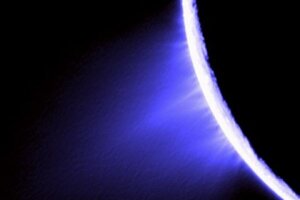Cassini spacecraft finds evidence for liquid water on Enceladus

Plumes of water ice emerge from deep within Saturn's moon Enceladus. These ices refresh Saturn's E ring. Scientists have found salts in the E ring that speak to the interaction of water and rock under the moon's icy surface.
NASA
In the hunt for potential habitats for life beyond Earth, Saturn's moon Enceladus is looking better and better.
The latest boost to the moon's profile appears not at the moon itself, but in Saturn's outermost ring, the E ring. Enceladus shepherds the ring, which it formed and renews by spewing ice grains into space via the plumes venting from its South Pole region.
This week, scientists reported that they've detected the chemical equivalent of table salt and baking soda in some of the E ring's grains.
The only way those compounds could form, researchers say, is through the interaction of liquid water and rock. And the only spot in the neighborhood where those kinds of reactions could take place is Enceladus, with its rocky core, and at least early in its history, an ocean beneath its icy crust.
The results appear in the current issue of the journal Nature.
It's a major discovery, says Mikhail Zolotov, a planetary scientist at Arizona State University in Tempe, who wasn't involved in the work -- and a gratifying one.
Two years ago, he used geochemical models to explore the question of how an ocean chemistry on Enceladus would change over time, especially if it continued to freeze at increasingly deeper depths. An early ocean, he says, would have been salty, though far less so than Earth's oceans. But he found that the main salts would be sodium chloride and sodium bicarbonate (yep, table salt and baking soda).
"We believe that the salty minerals deep inside Enceladus washed out from rock a the bottom of a liquid layer," notes Frank Postberg, a researcher at the Max Planck Institute for Nuclear Physics in Heidelberg, Germany. His team used the Cosmic Dust Analyzer on Cassini to capture and scrutinize samples of material from the E ring.
As for potential habitats, Dr. Postberg adds that if there is some sort of ocean (tiny by Earth standards; Enceladus is only 300 miles across), it would be slightly alkaline. Add heat (which Enceladus generates through internal friction as Saturn's gravity tugs and hauls on the moon, plus a dash of organic compounds (which scientists have detected in the moon's plumes), and you have a potential Motel 6 for simple life forms, or at least for the chemical precursors for organic life.
So what's the likelihood that an ocean lurks under Enceladus's icy skin?
Last year scientists from Germany and Britain published a theory about the mechanism driving the plumes, and it required the presence of an ocean of liquid water to work.
Dr. Zolotov says he has his doubts about an ocean, however.
"Currently, we do not have enough energy sources to maintain a large ocean," he says. But there is enough energy to maintain a layer of slushy brine deep beneath the moon's surface, perhaps as a thick layer between ice and rock, he adds. That brine would have formed as an ocean froze, driving the salts toward the bottom.
A second paper in this week's Nature describes a lack of sodium signatures in the spectra of Enceladus's plume and argues that the results don't support the notion of a salty sea supplying material for the plumes. Others suggest, however, that this is because the researchers involved were looking for sodium in atomic form, an approach that wouldn't detect the salts themselves.
Still, John Spencer, a planetary scientist with the Southwest Research Institute in Boulder, Colo., calls the discovery of salts in the E ring the "steaming gun" for liquid water near the surface of Enceladus. Perhaps it rests not in oceans, but in "misty ice caverns floored with pools and channels of salty water" hidden below the surface "tiger stripes" from which the plumes are emerging.
In a Nature commentary on the latest results, he concludes: "What else may lurk in those salty pools, if they exist, remains to be seen."
